ASUS Striker II Extreme: Mucho Bang, Mucho Bucks
by Kris Boughton on April 11, 2008 7:00 AM EST- Posted in
- Motherboards
Memory Write and Copy Performance
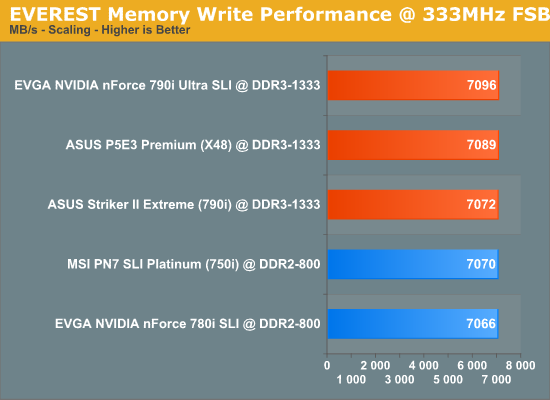
Memory write performance is almost solely dependent on FSB, although changes in absolute CAS latency can have a much smaller secondary affect. There is no clock crossing procedure needed when moving data across the FSB onto the memory bus during write operations; therefore total memory throughput is based largely on the speed of the interface and nothing more. DDR3 shows improvements over DDR2 in this regard.
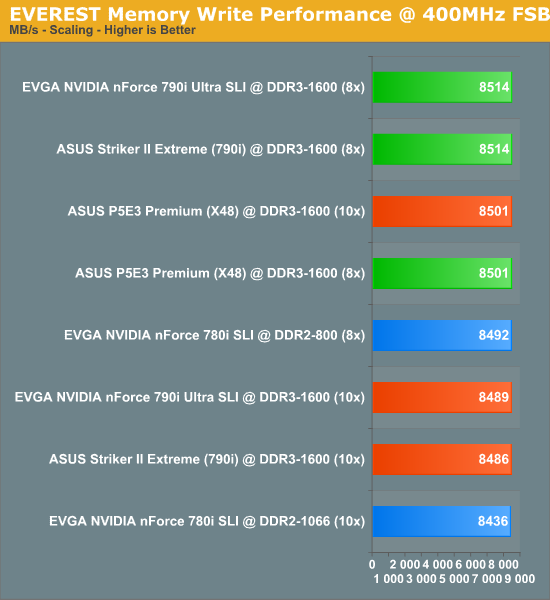
The trend carries on through 400MHz FSB where a 20% increase in FSB leads to an equivalent 20% increase in memory write performance.
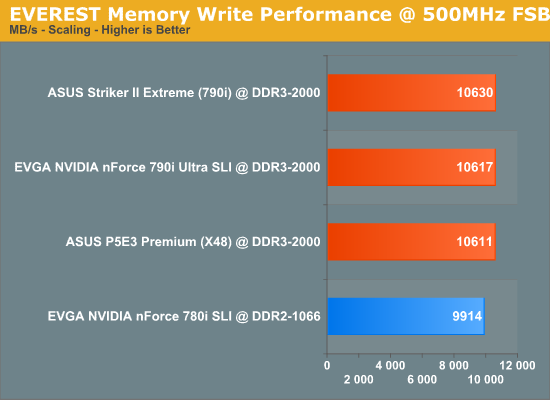
Each of the DDR3 boards continues scaling to 500MHz FSB with the expected 25% jump in memory write performance over 400MHz FSB. However, the DDR2-based 780i board stalled at just under 10GB/s signifying a rather serious problem with memory writes with this board. Whatever the problem was NVIDIA has obviously implemented the fix in 790i.
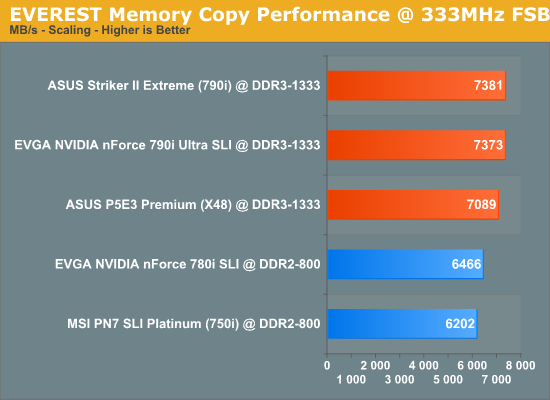
Memory copy benchmarks are unique in that they provide a great indication of just how well a memory controller balances the importance of read versus write requests. A chipset certainly cannot facilitate good copy speeds if read or write performance is low. The memory controller must first read the data from memory before it can write it back to memory (this is basis of a copy operation) and a bottleneck with either can bring everything to a crawl. Naturally, the DDR3 boards have an advantage in read performance at equivalent clock speeds and easily outclass the DDR2 boards.
To our surprise memory copy performance sometimes actually exceeded memory write speeds for the same FSB - in this case the 790i showed unexpected efficiency. A possible explanation for this phenomenon is the manner in which memory write requests are sometimes internally queued by the MCH until a lapse in memory read requests provides opportunity for a quick burst of write data to be sent across the memory bus, unimpeded by competing traffic.
In this respect, bandwidth as measured from the viewpoint of total memory throughput would be higher. Although the time to complete the pending write request might suffer, most writes are highly asynchronous - there would be little need for an instantaneous write operation unless an immediate read request depended on data stored by the same write to memory. In that case the controller could recognize this condition and simply read the data from the "cache line" without even touching main memory. You could almost argue that the MCH provided the functionality indicative of a highly specialized L3 cache in this particular situation.

We see here the roles reversed with the X48 Express chipset showing better memory copy performance than both 790i-based boards.
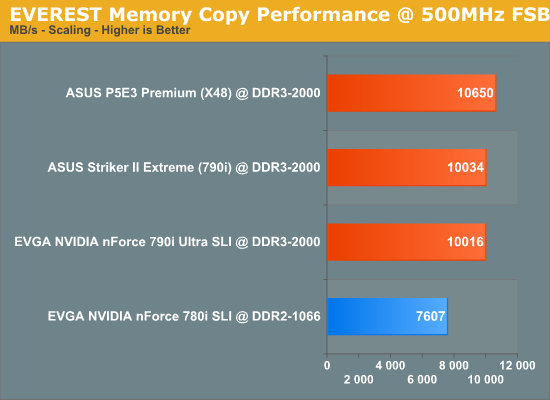
The Intel X48 Express wins again at 500MHz FSB, an oddity considering the commanding lead held by 790i when it comes to memory read performance at this system bus speed. We are tempted to give Intel's X48 the nod for the win, seeing as how it either wins or ties 790i in three out of four tests (memory access latency, memory write performance, and memory copy performance).










23 Comments
View All Comments
Rodriguez - Friday, June 20, 2008 - link
Can anyone here indicate how to reach FSB 500 (2000) with Striker II Extreme & QX9770 C1, most I can get is 1900FSB.I've seen Kris reach this speed in this article & was eager to get to this speed as soon as I received my new CPU, but it has been more difficult than I thought, I was sure that if with my previous Q6600 G0 y could easily get 1900/1950FSB, now with QX9770 would be peanuts. The main reason I bought this CPU was to run 2000FSB linked & synced with Ballistix 2000 SLI.
Please give all detailed BIOS setup options for this CPU if possible
Nobody in Asus forum using this setup has been able to reach 2000FSB, but I have seen a few reviews (like Anandtech's) & posts showing it's possible
By the way, memory has been tested unlinked at 2000Mhz 9-8-8-24, 1.9v P1/P2 Enabled & works great
System:
QX9770 rev. C1 3.2Ghz (watercooled)
Asus Striker II Extreme BIOS 801, ver 1.02G (watercooled)
PC Power & Cooling Turbo Cool 1200W
4 x 1GB Crucial Ballistix PC16000 SLI EPP2 , 2000Mhz 1800 8-7-7-24- 1T - 1.9v
SLI Leadtek PX8800 Ultra Leviathan (factory watercooled)
SLI Leadtek PX8800 Ultra
Asus Physx card (removed)
Dlink DWA556 PCIx Xtreme N Wireless card
2x WD Raptor 150GB Raid 0 300GB
1x Seagate 400GB Sata
X-Fi Platinum Fatal1ty Champion
24' Benq FP241VW Gamer
Innovatek XXD Rev 2 + G-Flow water cooling
CoolerMaster Cosmos 1000 case
Saitek X52 Flight system
TrackIR 4 + Trackclip Pro
Windows Vista Home Premium 32bit
parkerdw - Tuesday, June 3, 2008 - link
I used the same motherboard and cpu, but I liquid cooled it using the gigantic Kandalf Liquid Cooled case. My memory is different as well since I use 4 GB of Patriot Viper memory (2 x 2GB). Other than the memory settings in the BIOS, I set everything to match this guide. My system runs at 4.0Ghz and the cpu runs at no more than 88 degrees fahrenheit even while playing something like Crysis with everything set to Very High. Crysis runs between 35 and 60 fps on Very High on my system using a single 9800 GX2 at 1280 x 720. It's a HTPC connected to my older 56 inch DLP set via DVI, so I can't go any higher than that, but I fully expect to run great at 1080p when I get my new large screen set later this year. I don't have my bios settings in front of me, but setting everything to Auto for the memory works PERECTLY at 4.0 ghz. Pretty cool. I think it's running at 8,8,18 or so and 1.9v.Also, Asus just released a patch to the bios that fixes the data corruption issue mentioned in this artcle. Released on 5/29/08 I think.
hardist - Monday, April 21, 2008 - link
The water block seems to have leaking issues , I am wondering why it was not covered in this review since it is a major feature of this board ......Heatlesssun - Sunday, April 20, 2008 - link
This is a sweet motherbaord! Now I've not overclocked the FSB, just bumped up the multiplier of my QX9650 from the default of 9.5 to 10, and I'm not running RAID. We shall see but I feel good. To get this up and running with Vista x64 in a day so smoothly was pretty good I thought.electricx - Tuesday, April 15, 2008 - link
So this board is going for the aforementioned amount on newegg... The EVGA and the XFX 790i boards are going for $350... The ROG name carries that much of a premium? I mean, come on?! I'm sure ASUS will fix this data corruption issue and you typically do pay more for the privilege(?) of being a beta tester for high end hardware but $1000 over competing products seems a bit much... The EVGA board is looking to be a clear winner here to me. Time will tell I suppose.FightingEagle - Friday, April 18, 2008 - link
After the second EVGA 790i and full of bugs I just sent it back. I was interested in the ASUS X48 and the 790i, but the 790i over $400 is hard to grasp. EVGA has good looking heat sink but not very good at cooling. I may wait for all the bugs to leave but as now im sitting on $320 dollars worth of DDR3 and a E8400.electricx - Tuesday, April 15, 2008 - link
Edit: That should have been $100 not $1000UK1Man - Sunday, April 13, 2008 - link
Help please!!I'm currently in the process of building a computer but can only afford to buy a couple of parts a month, I have already purchased some DDR2 (1066) memory for an FXF 780 motherboard (not yet purchased) but am now considering the Asus striker II extreme.
Will my DDR 2 memory work with this?
seamusmc - Monday, April 14, 2008 - link
This board/chipset, 790i, only supports DDR3.ianken - Saturday, April 12, 2008 - link
Can it go into S3 suspend and come back out and have the NICs still work? The Striker 2 Formula cannot.Can the SATA controller handle hot swap? The Stiker 2 Formula and the previous 680i boards could not. The 680i bios even had an esata setting that did NOTHING.
The latest crop of Asus boards, particularly the NV chipset rigs, have been pretty buggy and basic functionality has been borked.
But hey, who cares of the basics don't work right? it's got a water block for X-TREME OVERCLOXORS! YO! VTEC!